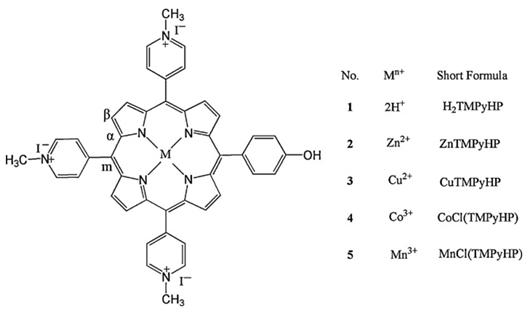Introduction
Porphyrin is a highly conjugated aromatic system that has strong absorption in the visible region and generally has a deep color. Owing to these advantages, porphyrin photosensitizers have attached considerable interest and are applied to molecular probes and photodynamic therapy (PDT). Porphyrin photosensitizers also play an indispensable and important role in various physiological activities, such as chlorophyll for photosynthesis, hemin of respiration and so on. Porphyrin photosensitizers not only have unique physiological activity but also have a unique affinity with cancer cells. In addition, porphyrin photosensitizers exhibit low dark toxicity for cells, great biological compatibilities and good light stability that can produce active oxygen to kill the tumor cells under light exciting and preferentially accumulate in proliferating cells.
 Figure 1. The structure of chlorophyll and hemin
Figure 1. The structure of chlorophyll and hemin
Categories
According to the structure of the porphyrin photosensitizers, the common porphyrin photosensitizers can be divided into the following categories.
Porphyrin photosensitizers containing nitric oxide (NO) donors play an important part in the field of porphyrin photosensitizers. It is worth noting that NO serves as a key intermediate in a number of biological processes, including neurotransmission and regulation of blood pressure. Meanwhile, NO plays a critical part in the tumoricidal activity of the immune system. NO with high concentration was cytotoxic and could induce the apoptosis of tumor cells sequentially preventing tumors from metastasizing. A series of novel porphyrin photosensitizers containing NO donors were designed and synthesized and their biological activities were evaluated.[1] The results suggest that porphyrin photosensitizers containing NO donors not only were able to release NO with a high percentage but also assist macrophages to kill the tumor.
 Figure 2. The structures of nitric oxide porphyrin
Figure 2. The structures of nitric oxide porphyrin
- Glycoconjugeted Porphyrin
In order to improve the solubility and targeting, the introduction of glycosyl groups into the main body of porphyrin has become a research hotspot in recent years. Moreover, the carbohydrate-protein interactions have many important biological functions, such as receptor-mediated endocytosis, metastasis and pathogenic infections.[2] The aggregation effect will appear that results in better cell recognition when multivalent carbohydrates interact with more than one receptor-binding site simultaneously and cooperatively. Besides, the glycoconjugate porphyrin provides an amphiphilic character and can favor their interactions with the tumor cell membrane.
Given transition-metal complexes have unique physicochemical properties, the combination of porphyrin photosensitizers with transition-metal leads to novel chemotherapeutics and a greatly expanded ability for chemists to probe DNA.[3] Metalloporphyrins have a number of advantages, including stable, inert and water-soluble. Moreover, metalloporphyrins contain spectroscopically active metal centers which have extreme value in the researches of biological systems. The metals of porphyrin greatly restrain the self-aggregation and consequently increase the yield of singlet oxygen (1O2) in the DNA photocleavage experiments, which have been applied to probe both structural and functional aspects of nucleic acid chemistry.
 Figure 3. The structures of metalloporphyrin
Figure 3. The structures of metalloporphyrin
Alfa Chemistry is committed to providing a wide range of porphyrin photosensitizers, if you do not find what you need, please contact us.
References
- Liu W.; et al. Porphyrins containing nitric oxide donors: synthesis and cancer cell-oriented NO release. Z. Sust. Energ. Rev. 2009, 19(6): 1647-1649.
- Ballut S.; et al. A strategy for the targeting of photosensitizers. Synthesis, characterization, and photobiological property of porphyrins bearing glycodendrimeric moieties. J. Org. Chem. 2011, 76(7): 2010-2028.
- Zhao P.; et al. DNA binding and photocleavage specificities of a group of tricationic metalloporphyrins. Spectrochim. Acta A 2010, 75(3): 1108-1114.


 Figure 1. The structure of chlorophyll and hemin
Figure 1. The structure of chlorophyll and hemin Figure 2. The structures of nitric oxide porphyrin
Figure 2. The structures of nitric oxide porphyrin Figure 3. The structures of metalloporphyrin
Figure 3. The structures of metalloporphyrin